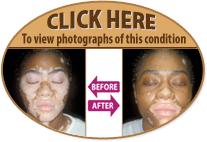 Vitiligo is a depigmenting disorder characterized by loss of melanocytes from the epidermis, mucous membranes, hair bulb, inner ear, eye, and leptomeninges. This disorder affects 1 – 2% of the population, both sexes equally, and all ages. Although vitiligo can occur in all ethnic groups it is more noticeable in dark-skinned individuals, making the disorder more psychologically devastating in this group because of the marked contrast between normal and affected skin.
Vitiligo is a depigmenting disorder characterized by loss of melanocytes from the epidermis, mucous membranes, hair bulb, inner ear, eye, and leptomeninges. This disorder affects 1 – 2% of the population, both sexes equally, and all ages. Although vitiligo can occur in all ethnic groups it is more noticeable in dark-skinned individuals, making the disorder more psychologically devastating in this group because of the marked contrast between normal and affected skin.
The etiology is unknown, but a genetic and/or autoimmune etiology is often suspected. The presence of circulating antibodies directed against melanocyte cell-surface antigens that kill melanocytes in vivo and in vitro has been found in the blood of patients with vitiligo.
Vitiligo is associated with several autoimmune disorders, including thyroid disorders (particularly Hashimoto thyroiditis and Grave disease), Addison disease, diabetes mellitus, alopecia areata, pernicious anemia, systemic lupus erythematosus, inflammatory bowel disease, rheumatoid arthritis, psoriasis, and autoimmune polyglandular syndrome.
Vitiligo is diagnosed almost exclusively by physical examination. A Wood’s lamp examination accentuates vitiligo patches. There are five clinical variants of vitiligo: focal, segmental, generalized, acrofacial, or universalis. Generalized is the most common type. Segmental vitiligo has an earlier age of onset, is not associated with autoimmune diseases, and tends to be more resistant to treatment. Universalis type is associated with multiple endocrinopathies. Trichrome vitiligo is a term to describe adjacent areas of normal skin, hypopigmented skin, and depigmented skin.
 Current treatments include sunscreens, cosmetics, topical therapies, systemic therapies, phototherapies, depigmentation, surgery, and melanocyte transplantation. Vitiligo patches are more vulnerable to the ultraviolet rays, so sunscreens are necessary to prevent sunburn, lessen the contrast between vitiligo and normal skin, and reduce the chance for koebnerization. Topical therapies include corticosteroids, immunomodulators, calcipotriol, and pseudocatalase. Systemic therapy includes oral and intralesional corticosteroids. In addition to PUVA and narrow band UVB, excimer laser is also an effective photodynamic therapy for vitiligo. Depigmentation with monobenzoyl ether of hydroquinone is consider only when patients have >50% cutaneous involvement and have shown recalcitrance to repigmentation from various treatment modalities; or disfiguring facial involvement. Surgical therapies for vitiligo include mini-punch grafts, thin split-thickness grafts, and suction blister grafts. Finally, melanocyte transplantation via autologous pure melanocyte; or autologous melanocyte and keratinocytes co-cultures. While there are no cures yet for vitiligo, promising treatments exist.
Current treatments include sunscreens, cosmetics, topical therapies, systemic therapies, phototherapies, depigmentation, surgery, and melanocyte transplantation. Vitiligo patches are more vulnerable to the ultraviolet rays, so sunscreens are necessary to prevent sunburn, lessen the contrast between vitiligo and normal skin, and reduce the chance for koebnerization. Topical therapies include corticosteroids, immunomodulators, calcipotriol, and pseudocatalase. Systemic therapy includes oral and intralesional corticosteroids. In addition to PUVA and narrow band UVB, excimer laser is also an effective photodynamic therapy for vitiligo. Depigmentation with monobenzoyl ether of hydroquinone is consider only when patients have >50% cutaneous involvement and have shown recalcitrance to repigmentation from various treatment modalities; or disfiguring facial involvement. Surgical therapies for vitiligo include mini-punch grafts, thin split-thickness grafts, and suction blister grafts. Finally, melanocyte transplantation via autologous pure melanocyte; or autologous melanocyte and keratinocytes co-cultures. While there are no cures yet for vitiligo, promising treatments exist.

